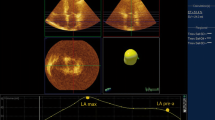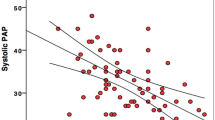Abstract
The correlation of P wave indices on surface ECG and phasic LA dysfunction in patients with significant primary mitral regurgitation (MR) due to the adverse LA adaptive structural and functional changes needs to be more studied. This study aims to investigate the diagnostic value of P wave indices to predict LA function assessed both by volumetric analysis using 3-dimensional (3D)echocardiography, and by strain analysis using speckle tracking echocardiography. (STE). The study included 107 subjects, we measured maximum P-duration (Pmax), P dispersion (PD), and V1 negative terminal force (V1-NTF) (negative duration x negative amplitude) on surface ECG. Both Basic and Dynamic LA volumes (LAV) during reservoir, conduit, and contractile phases were measured. The global LA strain and strain rate parameters were calculated By STE. LA ejection fraction (LAEF) and ejection force were also calculated.V1-NTF showed a significant positive correlation while P-max a significant negative correlation with global peak atrial longitudinal strain (GPALS) (r = 0.75; P < 0.001 and r = − 0.72; P < 0.001 respectively). Using ROC curve analysis, Pmax > 110 ms, 1-NTF ≥ 4 ms.mV and P notching > 40 ms had a sensitivity of 90%, 95% and 50% and a specificity of 87.4%, 94.3% and 100% respectively in predicting GPALS ≤ 30%. P notching > 40 ms was associated with severe LA dysfunction. ECG P wave indices represent a simple bedside tool that could have an incremental role in predicting LA dysfunction as well as size in patients with significant primary MR.




Similar content being viewed by others
Data availability
All data and materials are available.
Abbreviations
- LA:
-
Left atrium
- MR:
-
Mitral regurgitation
- 6MWD:
-
Six minute walk distance
- BMI:
-
Body mass index
- BSA:
-
Body surface area
- NYHA:
-
New York Heart Association
- P:
-
P wave
- P max:
-
Maximum P wave duration
- P min:
-
Minimum P wave duration
- NPD:
-
Negative P wave component duration
- NPA:
-
Negative P wave component amplitude
- V1-NTF:
-
P wave terminal force in lead V1
- PALS:
-
Peak atrial longitudinal strain
- PACtS:
-
Peak atrial contractile strain
- SR:
-
Srain rate
- LAEF:
-
LA total emptying fraction
- GPALS:
-
Global peak LA strain
- GPACS:
-
Global peak left atrial contractile strain
- TPLS:
-
Time to peak longitudinal strain
References
Reed D, Abbott RD, Smucker ML et al (1991) Prediction of outcome after mitral valve replacement in patients with symptomatic chronic mitral regurgitation. The importance of left atrial size. Circulation 84:23–34
Grigioni F, Avierinos JF, Ling LH et al (2002) Atrial fibrillation complicating the course of degenerative mitral regurgitation: determinants and long-term outcome. J Am Coll Cardiol 40(1):84–92
Langeland S, D’Hooge J, Wouters PF et al (2005) Experimental validation of a new ultrasound method for the simultaneous assessment of radial and longitudinal myocardial deformation independent of insonation angle. Circulation 112:2157–2162
Todaro MC, Choudhuri I, Belohlavek M et al (2012) New echocardiographic techniques for evaluation of left atrial mechanics. Eur Heart J Cardiovasc Imaging 13:973–984
Lang RM, Badano LP, Mor-Avi V (2015) Recommendations for cardiac chamber quantification by echocardiography in adults: an update from the American Society of Echocardiography and the European Association of Cardiovascular Imaging. J Am Soc Echocardiogr 28:1–39
Abhayaratna WP, Seward JB, Appleton CP et al (2006) Left atrial size: physiologic determinants and clinical applications. J Am Coll Cardiol 47(12):2357–2363
Mondillo S, Cameli M, Caputo ML et al (2011) Early detection of left atrial strain abnormalities by speckle-tracking in hypertensive and diabetic patients with normal left atrial size. J Am Soc Echocardiogr 24(8):898–908
Muranaka A, Yuda S, Tsuchihashi K et al (2009) Quantitative assessment of left ventricular and left atrial functions by strain rate imaging in diabetic patients with and without hypertension. Echocardiography 26(3):262–271
Cameli M, Lisi M, Mondillo S et al (2010) Left atrial longitudinal strain by speckle tracking echocardiography correlates well with left ventricular filling pressures in patients with heart failure. Cardiovasc Ultrasound 8(1):14
Azemi T, Rabdiya VM, Ayirala SR et al (2012) Left atrial strain is reduced in patients with atrial fibrillation, stroke or TIA, and low risk CHADS(2) scores. J Am Soc Echocardiogr 25(12):1327–1332
Pagola J, González-Alujas T, Flores A et al (2014) Left atria strain is a surrogate marker for detection of atrial fibrillation in cryptogenic strokes. Stroke 45(8):e164–e166
Cameli M, Lisi M, Giacomin E et al (2011) Chronic mitral regurgitation: left atrial deformation analysis by two dimensional speckle tracking echocardiography. Echocardiogr 28:327–334
Ancona R, Comenale Pinto S, Caso P et al (2013) Two-dimensional atrial systolic strain imaging predicts atrial fibrillation at 4-year follow-up in asymptomatic rheumatic mitral stenosis. J Am Soc Echocardiogr 26(3):270–277
Corradi D, Callegari S, Maestri R et al (2012) Differential structural remodeling of the left-atrial posterior wall in patients affected by mitral regurgitation with or without persistent atrial fibrillation: a morphological and molecular study. J Cardiovasc Electrophysiol 23:271–279
Debonnaire P, LeongDP Witkowski TG et al (2013) Left atrial function by two-dimensional speckle-tracking echocardiography in patients with severe organic mitral regurgitation: association with guidelines-based surgical indication and postoperative (Long-Term) survival. J Am Soc Echocardiogr 26:1053–62
Moustafa SE, Alharthi M, Kansal M et al (2011) Global left atrial dysfunction and regional heterogeneity in primary chronic mitral insufficiency. Eur J Echocardiogr 12:384–393
Cameli M, Lisi M, Righini FM (2012) Left atrial speckle tracking analysis in patients with mitral insufficiency and history of paroxysmal atrial fibrillation. Int J Cardiovasc Imaging 28:1663–1670
Huo Y, Mitrofanova L, Orshanskaya V et al (2014) P-wave characteristics and histological atrial abnormality. J Electrocardiol 47:275–280
Cameli M, Lisi M, Righini FM et al (2013) Usefulness of atrial deformation analysis to predict left atrial fibrosis and endocardial thickness in patients undergoing mitral valve operations for severe mitral regurgitation secondary to mitral valve prolapse. Am J Cardiol 111:595–601
Tiffany Win T, Ambale Venkatesh B, Volpe GJ et al (2015) Associations of electrocardiographic P-wave characteristics with left atrial function, and diffuse left ventricular fibrosis defined by cardiac magnetic resonance: The PRIMERI Study. Heart Rhythm 12:155–162
Vural MG, Cetin S, Yilmaz M et al (2015) Relation between left atrial remodeling in young patients with cryptogenic stroke and normal inter-atrial anatomy. J Stroke 17:312–319
de Luna AJB (1979) Block at the auricular level. Rev Esp Cardiol. 32(1):5–10
Kottkamp H (2013) Human atrial fibrillation substrate: towards a specific fibrotic atrial cardiomyopathy. Eur Heart J 34(35):2731–2738
Verheule S, Wilson E, Everett T et al (2003) Alterations in atrial electrophysiology and tissue structure in a canine model of chronic atrial dilatation due to mitral regurgitation. Circulation 107:2615–2622
Bailey GW, Braniff BA, Hancock EW et al (1968) Relation of left atrial pathology to atrial fibrillation in mitral valvular disease. Ann Intern Med 69:13–20
Guidera SA, Steinberg JS (1993) The signal-averaged P wave duration: a rapid and noninvasive marker of risk of atrial fibrillation. J Am Coll Cardiol 21:1645–1651
Soliman EZ, Prineas RJ, Case LD et al (2009) Ethnic distribution of ECG predictors of atrial fibrillation and its impact on understanding the ethnic distribution of ischemic stroke in the Atherosclerosis Risk in Communities (ARIC) study. Stroke 40(4):1204–1211
Ishida K, Hayashi H, Miyamoto A et al (2010) P wave and the development of atrial fibrillation. Heart Rhythm 7(3):289–294. https://doi.org/10.1016/j.hrthm.2009.11.012 (Epub 2009 Nov 12)
Nielsen JB, Kühl JT, Pietersen A et al (2015) P-wave duration and the risk of atrial fibrillation: Results from the Copenhagen ECG Study. Heart Rhythm 12(9):1887–1895
Funding
No funding was received for conducting this study.
Author information
Authors and Affiliations
Contributions
HR shared in planning the research then guided and supervised the methodology, revised the manuscript. SB supervised the research methodology and shared in revising the manuscript.RM collected and analysed the data and was a major contributor in writing the manuscript.RS shared in the research work and writing the manuscript.
1. All authors of this research paper have directly participated in the planning, execution, or analysis of this study.
2. All authors of this paper have read and approved the final version submitted.
Corresponding author
Ethics declarations
Conflict of interest
The authors declare that they have no conflict of interest.
Ethical approval
This research is approved by local ethical committee of cairo university hospitals (reference no.is not available) and an informed written consent was taken from patients included in this study.
Consent for publication
Not applicable.
Additional information
Publisher's Note
Springer Nature remains neutral with regard to jurisdictional claims in published maps and institutional affiliations.
Rights and permissions
About this article
Cite this article
Darweesh, R., Rizk, H., Bakhoum, S. et al. Incremental value of P-wave indices for predicting left atrial dysfunction in patients with primary mitral regurgitation using speckle tracking echocardiography. Int J Cardiovasc Imaging 38, 91–102 (2022). https://doi.org/10.1007/s10554-021-02372-3
Received:
Accepted:
Published:
Issue Date:
DOI: https://doi.org/10.1007/s10554-021-02372-3




